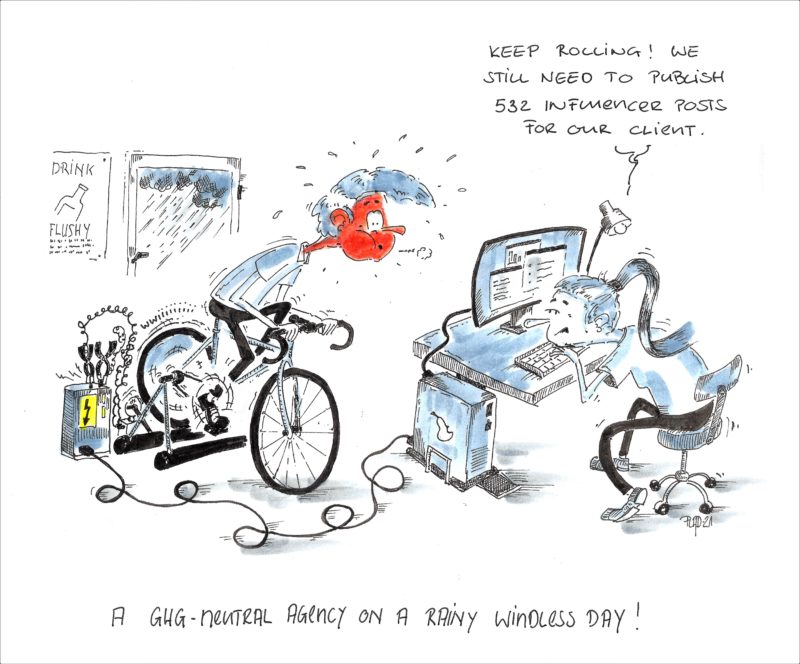Woolley Marketing: Net Zero Emissions and Marketing
In his regular Mumbrella column, Trinity P3 founder and global CEO Darren Woolley urges marketers to listen to the demand when it comes to going green.
Why is marketing so late to the net zero greenhouse gas (GHG) emissions targets? What I mean here is that there is a tipping point, where business and government align on achieving an agreed net zero emissions target, and everyone gets on with doing the work to achieve it. Already we are seeing governments around the world setting and agreeing targets for their countries, and major businesses and corporations getting to work looking at ways they can achieve their net zero emissions by the agreed date.

Cartoon by Dennis Flad, published with permission (2021)
Operations, finance and procurement are all leading the way with productive conversations, internally and externally, around what is often referred to as Scope 3 emissions. This is the supply and distribution chain for your products and services.
But where is marketing in all this, and particularly advertising? These are often the most visible expressions of a business and its services. Considering it is estimated that the ‘average’ person sees 6,000 – 10,000 advertising messages every day, this is a huge amount of activity. Activity that is contributing to the emission of greenhouse gases. So, why is marketing often overlooked or not a priority when it comes to the discussion on achieving net zero emissions by 2030? Or 2040? Or even 2050?
Well, there are a few dilemmas facing marketing and marketers when it comes to addressing their contribution to the climate crisis.
The first is fundamental to the role of marketing in driving consumption. One of the key objectives of marketing and the associated investment is to drive consumption of the relevant product or service you are advertising. How is a marketer meant to reconcile this core objective with reducing the GHG emissions that come with the marketing activity? Let’s take a view of the bigger picture. Great marketing will drive success of a brand, product or service. But likewise, great marketing will also make poor brands, products and services fail faster. Yes, there is little point reducing GHG emissions for marketing if the marketing is encouraging high-polluting products and services. But if the organisation is working to achieve net zero emissions, then marketing is an essential part of that effort.
The second is the belief that marketing has a relatively small GHG emission. This is not necessarily true. One of the largest contributions to GHG emissions is power generation in markets using fossil fuels such as coal and gas. In fact, power generation has its own scope of GHG emissions, Scope 1. But the truth is, with the transformation to largely digital broadcast and digital advertising distribution, electricity is what powers the advertising market. Those billions of ads delivered each day are consuming gigawatt hours of power and contributing millions of tonnes into the atmosphere as GHGs. So, while you may think that having reduced dependence on printed materials you have reduced your GHG emissions, the fact is that digital is a huge consumer of electricity and depending on the sources, could be the cause of significant GHG emissions.

Third, many in marketing believe that work done at an organisational level will reduce GHG emissions in marketing. While this is potentially true for Scope 1 and 2 emissions, it is actually the marketing supply that is the biggest issue. This is also where the marketing and advertising budget is spent and therefore the biggest opportunity to influence the overall category, by becoming a savvy marketing buyer in the same way procurement is leading the charge to sustainable net zero emissions. Ironically, many marketers think this means paying more for their marketing and advertising. But the truth is that with a focus on reducing GHG emissions you are effectively reducing duplication and waste, which can deliver savings in the medium to long term. The concept of additional cost for doing the right thing is a hangover from the idea of paying for carbon offsets. But the focus today is on looking to source from low carbon suppliers, and in the process reducing costs.
The fact is that for marketers working for organisations with a commitment to net zero emissions, there are more reasons as to why marketing should be part of the leadership mix than just an afterthought. Marketing is a driver of consumer demand, and the demand is for organisations to offer products and services that reduce GHG emissions. Marketing is the visible face of many brands and businesses, through their advertising and marketing activities. Marketing in many organisations can be a significant contributor to GHG emissions and therefore should be included in the mix. And even better, there is an opportunity in that in reducing the GHG emissions for marketing, you will not only be able to reduce cost, but reduce waste and duplication and make the marketing strategy more targeted and effective.
Sounds like a win-win all round.

Darren Woolley is the founder and global CEO at Trinity P3. Woolley Marketing is a regular Mumbrella column.

